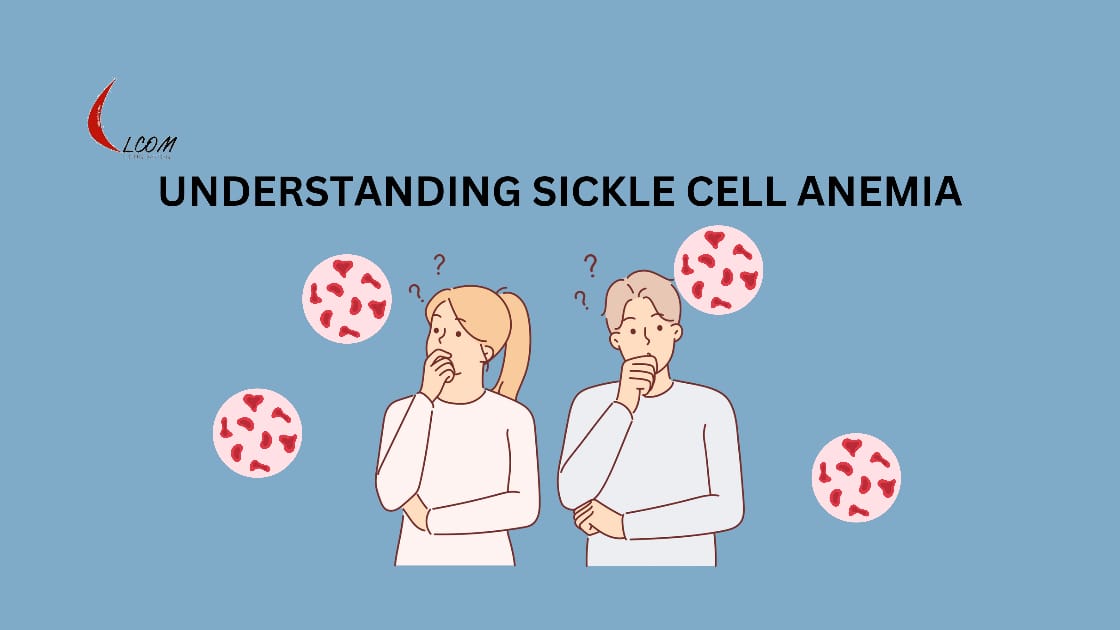
What is Sickle Cell Disease?:
SCD is a complex genetic disorder that primarily affects the structure and function of red blood cells. At the core of this condition is a genetic mutation in the HBB gene, which encodes the beta-globin subunit of hemoglobin, the protein responsible for carrying oxygen in red blood cells. In individuals with SCD, this mutation causes the production of abnormal hemoglobin called hemoglobin S (HbS). Unlike normal hemoglobin (HbA), HbS has a tendency to form long, rigid strands when oxygen levels are low, causing the affected red blood cells to adopt a characteristic crescent or “sickle” shape. These misshapen cells are less flexible and can easily become stuck in blood vessels, leading to various complications.
SCD encompasses several different genotypes, with the most common being sickle cell anemia (HbSS), where individuals inherit two copies of the mutated gene (one from each parent). Other genotypes, such as HbSC and HbS-beta thalassemia, result from inheriting one normal and one mutated gene, leading to milder symptoms compared to HbSS.
What SCD Isn’t (Disproving The Myths)¹
- Not Contagious:
SCD is an inherited genetic disorder and cannot be transmitted through contact with affected individuals. It’s important to dispel misconceptions that SCD can be “caught” like an infectious disease.
- Not a Lifestyle Choice:
SCD is not a result of lifestyle choices or behaviors. It’s a genetic condition that individuals are born with, and they have no control over whether they inherit the affected genes from their parents.
- Not Limited to a Specific Group:
While SCD is more prevalent in certain populations, particularly those of African, Mediterranean, Middle Eastern, and South Asian descent, it can affect individuals from diverse racial and ethnic backgrounds. SCD occurs wherever the gene mutations responsible for the condition are present, and it can affect anyone, regardless of their ethnicity.
Stigma SCD Patients Face
Unfortunately, there is a significant stigma associated with SCD in some communities, often stemming from a lack of understanding about the disease. This stigma can lead to social isolation and discrimination against individuals living with SCD.
Some of this stigmas come from common misconceptions including the belief that SCD is a result of “bad blood” or that it’s a form of contagious illness. These misconceptions can lead to fear and misunderstanding within communities affected by SCD. Education and awareness campaigns are crucial for dispelling these myths and promoting a more empathetic and informed perspective on the condition.
Medical Conditions Associated with SCD²
- Pain Crisis:
Individuals with SCD often experience severe and unpredictable episodes of pain, known as pain crises. These crises occur when sickle-shaped red blood cells block blood flow through small blood vessels. The pain can be excruciating and may require hospitalization and pain management with medications.
- Anemia:
SCD can lead to chronic anemia because the misshapen red blood cells are fragile and have a shorter lifespan than normal red blood cells. This results in reduced oxygen-carrying capacity, leading to fatigue, paleness, and weakness.
- Organ Damage:
Over time, SCD can cause damage to various organs, including the spleen, liver, lungs, and kidneys. Organ damage can result from reduced blood flow and oxygen supply.
- Susceptibility to Infections:
Individuals with SCD have weakened immune systems, making them more susceptible to infections, particularly those caused by bacteria. This vulnerability can lead to frequent illnesses and complications.
- Stroke:
SCD increases the risk of stroke, especially in children. Blocked blood vessels in the brain can lead to a lack of oxygen and neurological damage.
- Acute Chest Syndrome:
This is a severe and potentially life-threatening complication characterized by chest pain, fever, and difficulty breathing. It often requires hospitalization and treatment with oxygen and antibiotics.
- Priapism:
Males with SCD can experience priapism, a painful and prolonged erection that can lead to damage to the penis if not treated promptly.
Medication and Treatment
Hydroxyurea:
This medication is commonly prescribed to reduce the frequency and severity of pain crises in SCD. It works by increasing the production of a different type of hemoglobin (HbF), which interferes with the polymerization of HbS, reducing the sickling of red blood cells.
- Blood Transfusions:
In severe cases or during certain complications, such as acute chest syndrome or stroke, individuals with SCD may receive blood transfusions to increase the number of healthy red blood cells.
- Bone Marrow or Stem Cell Transplants:
For a small number of individuals with severe SCD, a bone marrow or stem cell transplant may be considered. This procedure involves replacing the patient’s bone marrow with healthy donor marrow to produce normal red blood cells.
Management and Lifestyle
- Individuals with SCD must adopt a variety of lifestyle strategies to manage their condition effectively. These may include staying well-hydrated to prevent dehydration, avoiding extreme temperatures that can trigger crises, and managing stress.
- Regular medical check-ups are crucial for monitoring the condition, identifying complications early, and adjusting treatment plans as needed.
Advancements in Treatment
Sickle cell disease (SCD) is a complex genetic blood disorder that has posed significant challenges for both patients and the medical community for many years. However, there is hope on the horizon as advancements in the treatment of SCD have been steadily progressing. These advancements offer the promise of improving the lives of those affected by the disease and even potentially finding a cure.
Gene Therapy and Gene Editing³
One of the most promising areas of advancement in SCD treatment is gene therapy and gene editing. These innovative approaches aim to address the root cause of the disease—the genetic mutation responsible for the abnormal hemoglobin production.
- Gene Therapy:
Gene therapy involves introducing functional copies of the HBB gene (the gene responsible for hemoglobin production) into a patient’s cells. This can be done using various techniques, including viral vectors that deliver the corrected gene into bone marrow cells where red blood cells are produced. The goal is to have these corrected genes produce normal hemoglobin, reducing or eliminating the presence of sickle hemoglobin (HbS) in the patient’s bloodstream.
- Gene Editing:
Gene editing techniques, such as CRISPR-Cas9, hold immense potential in the treatment of SCD. These methods allow for precise modification of the patient’s own genetic code to correct the mutation responsible for SCD. Researchers are actively working on perfecting the delivery and accuracy of gene editing tools to safely and effectively edit the HBB gene in individuals with SCD.
Stem Cell Transplants
While stem cell transplants have been used to treat SCD for some time, recent advancements have improved their safety and effectiveness. Stem cell transplantation involves replacing the patient’s bone marrow (which produces the faulty red blood cells) with healthy donor marrow. This procedure can potentially cure SCD by providing a continuous supply of normal red blood cells.
Innovations in Pain Management
Managing the excruciating pain associated with SCD has been a major challenge. However, advances in pain management strategies are improving the quality of life for patients. This includes the development of novel medications that target the underlying causes of pain crises, rather than just alleviating symptoms.
- Hydroxyurea:⁴
While not a recent development, hydroxyurea continues to be a cornerstone of SCD management. It has been shown to reduce the frequency and severity of pain crises by increasing the production of fetal hemoglobin (HbF), which interferes with the polymerization of sickle hemoglobin (HbS). Ongoing research aims to optimize dosing and identify those who will benefit most from this medication.
Clinical Trials and Research Collaborations
Advancements in SCD treatment are driven by extensive research efforts and international collaborations. Clinical trials are essential in testing new therapies and evaluating their safety and efficacy.
- Global Initiatives:
Several global initiatives and consortia have been formed to advance SCD research and treatment. These collaborations bring together researchers, healthcare providers, and patients to accelerate progress.
Advancements in Pediatric Care
Pediatric care for SCD has improved significantly. Early diagnosis through newborn screening programs allows for prompt intervention and preventative measures. Penicillin prophylaxis, vaccinations, and regular follow-up care have reduced childhood mortality rates.
Patient Empowerment and Advocacy
Patient advocacy groups and organizations dedicated to SCD have played a vital role in advancing treatment options. They raise awareness, provide support, and advocate for increased funding for research and access to care.
Challenges and Future Directions⁵
While advancements in SCD treatment are promising, challenges remain. These include ensuring equitable access to emerging therapies, addressing the high cost of some treatments, and managing potential side effects and long-term risks associated with gene therapy and stem cell transplants.
In conclusion, the treatment landscape for sickle cell disease is evolving rapidly, with innovative approaches like gene therapy, gene editing, improved pain management, and increased collaboration among researchers and advocates. These advancements offer hope for not only better management of the disease but also the potential for a cure in the near future. While challenges persist, the dedication of the scientific and medical communities, coupled with the resilience of individuals and families affected by SCD, continues to drive progress and inspire hope for a brighter future for those living with this condition.
Reference:
- https://www.walkinlab.com/blog/debunking-myths-surrounding-sickle-cell-disease/
- https://www.cdc.gov/ncbddd/sicklecell/facts.html#:~:text=The%20sickle%20cells%20die%20early,acute%20chest%20syndrome%20and%20stroke.
- https://www.sciencedirect.com/science/article/abs/pii/B9780323898379000061
- https://medlineplus.gov/druginfo/meds/a682004.html#:~:text=Hydroxyurea%20is%20in%20a%20class,sickle%2Dshaped%20red%20blood%20cells.
- https://www.hematology.org/research/sickle-cell-disease-and-sickle-cell-trait/sickle-cell-research-priorities#:~:text=Strengthen%20Curative%20Therapies,therapies%20for%20patients%20with%20SCD.
